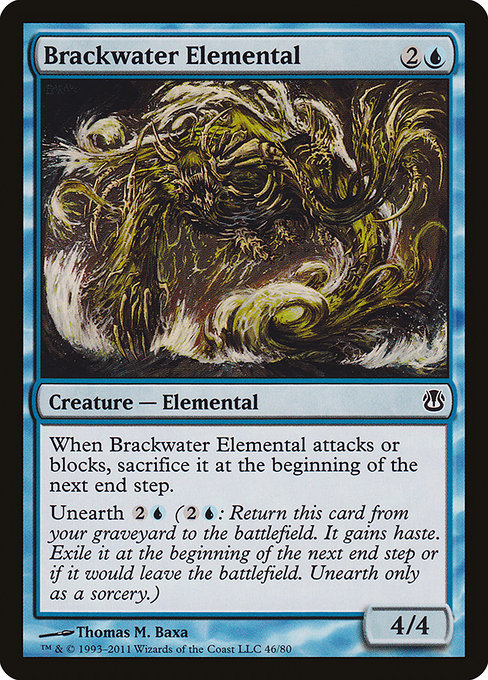
Image courtesy of Scryfall.com
Brackwater Elemental: intertextual currents in blue tempo
Magic: The Gathering has a long love affair with water, storms, and the unyielding pace of tempo strategies. Brackwater Elemental embodies that blue-slick tension: a sturdy 4/4 for three mana, with a risk and reward baked into every swing. When this creature attacks or blocks, you sacrifice it at the beginning of the next end step. It’s a design that rewards pressure and board presence, even as it asks you to plan your sea-slicked tempo carefully. 🧙♂️🔥
But the real trick here isn’t just the numbers on the card. It’s the way Brackwater Elemental invites intertextual play across MTG’s vast library. The creature’s fate—attack, then vanish at the end step—feels like a whispered nod to the older cycles of ephemeral threats that blue has perfected: threats that demand you squeeze as much value as possible from each moment on the battlefield. The blue mana identity, with its reliance on timing, counterplay, and careful resource management, becomes a chorus of echoes from set to set. This is blue storytelling at its most practical—a tempo pick that plays with the reader’s expectations, then rewrites them in the next turn. ⚔️🎨
Unearth and the time-honored trick of recursion
Brackwater Elemental’sUnearth ability—{2}{U} to return it from the graveyard with haste before exiling it at the end step or if it would leave the battlefield—lets you stitch a micro-time-loop into your game plan. It’s more than just bringing a creature back; it’s about reasserting pressure when your opponent thinks the coast is clear. In practice, you can swing, trigger the mandatory sacrifice, then Unearth the Elemental to threaten again in a later turn, effectively simulating multiple tempo engagements from a single mana investment. The care with which this cycle is constructed is a testament to how MTG designers thread old mechanics into new contexts. 🧙♂️💎
That layering—attack, sacrifice, recast—also invites a wider conversation about how intertextuality operates within a single duel deck and beyond. Brackwater Elemental sits in a lineage of blue creatures that flirt with danger and momentum: it’s a reminder that some of the strongest blue plays aren’t about lasting boards, but about making every moment count. The card’s placement in Duel Decks: Ajani vs. Nicol Bolas, a product of cross-faction storytelling, underscores how even a simple 4/4 can be a bridge between planewalkers, factions, and tactics across MTG’s multiverse. The result is a flavor-rich narrative that rewards players who read the surface and the subtext alike. 🧭⚡
Flavor and art as an expression of intertextuality
Thomas M. Baxa’s illustration for Brackwater Elemental captures the tension of water as a living battlefield—a swirling, shimmering engine behind a creature that’s equal parts threat and temporary guardian. The name “Brackwater” conjures a murky, treacherous seam where tides meet traps, a perfect metaphor for blue’s delicate balance between control and risk. The art, like the card’s mechanical rhythm, invites players to immerse themselves in a scene where physics and magic collide. It’s a visual argument for why MTG art matters as a language in its own right, whispering to the player to anticipate, react, and savor the moment of impact. 🎨💧
For collectors and players who adore cross-media resonance, the interplay between a card’s lore, its art, and its mechanical family tree is a continual source of delight. Brackwater Elemental stands as a small but vivid case study in how a single card can spark conversations about design lineage, intertextual references, and the way narrative threads braid through different MTG eras. 💎
Deck-building notes and practical playtips
- Tempo lane: Use Brackwater Elemental to apply early pressure while you build up countermagic and removal in blue. Its 4/4 body means a meaningful poke even when you’re racing the clock. ⚔️
- Unearth synergy: Plan for a secondary life in the graveyard. Unearth is a two-card combo with a lot of bite—get a temporary threat back with haste, then cash in another attack or block before the cycle ends. This is classic blue resilience with a twist. 🧙♂️
- Deck diversity: In Modern, Brackwater Elemental can slot into tempo or control shells that prize efficient threats and graveyard recursion, while remaining accessible to casual players in Commander’s broad formats. Its common rarity helps keep a tempo engine affordable for budget builds. 🔥
- Blending themes: Pair it with bounce and flicker effects to maximize value from each re-entry, or lean on counterspells to protect the on-field threat while you plan the next turn’s sequence. The card invites you to craft a microcosm of blue’s tempo philosophy. 🎲
As a design artifact, Brackwater Elemental teaches a powerful lesson: intertextuality in MTG isn’t just about lore; it’s about how a card’s mechanics talk to other cards, sets, and formats across time. It’s a conversation across eras—the sound of a tide pool that keeps murmuring for those who listen closely. 🧙♂️💬
Interested in a stylish way to display your MTG passion while you read streams of design essays or plan your next kitchen-table tournament? Check out the Neon Card Holder phone case—neon vibes for the avid collector on the go. It’s the perfect companion for a night of deck-building and card-slaying, where every detail matters as much as every draw. Shop smart, play bold. Neon Card Holder Phone Case MagSafe iPhone 13 / Galaxy S21-22
More from our network
- How Rebirth Breaks the Fourth Wall in MTG Design
- Estimating Absolute Brightness of a Hot Blue Giant at 2371 pc
- The Rise of Souls-Like Difficulty in Modern Games
- Shield Mare Cosplay: Lore-Inspired Armor from MTG Art
- How to Create Compelling User Personas for Digital Products
Neon Card Holder Phone Case MagSafe iPhone 13 / Galaxy S21-22